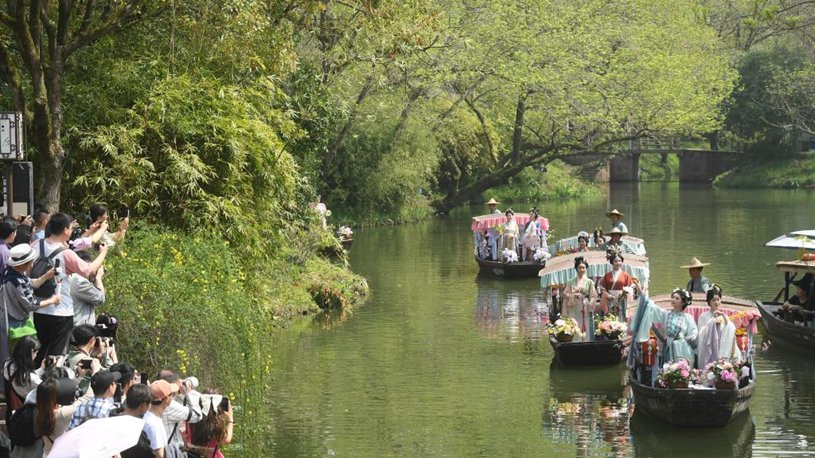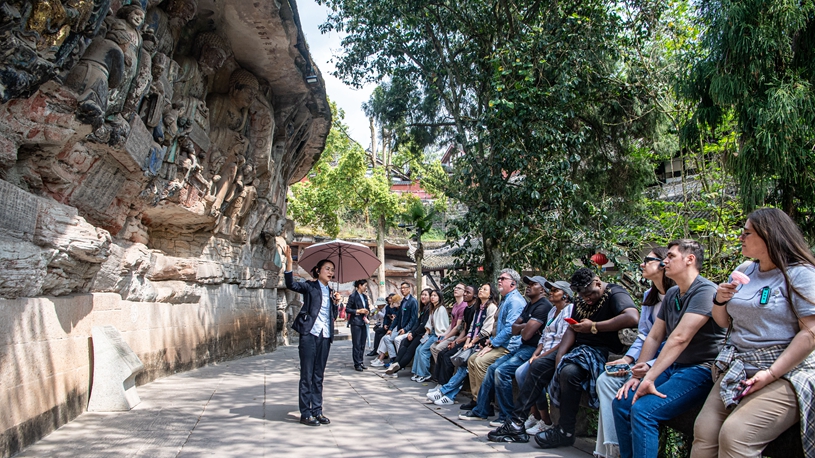HANGZHOU, March 31 (Xinhua) -- Standing in front of a horse-face skirt showcased in a garment factory, Liu Wenyue, 24, meticulously elaborated on the inspiration she drew from when designing it.
"I drew inspiration from the shell carving process used to create mother-of-pearl lacquer, an intangible cultural heritage in China. I chose the chromatic silver thread and images from traditional Chinese paintings -- birds, flowers, hills and rocks -- as the motifs. I also added window-frame patterns on the edge to give the entire piece the appearance of lacquerware," said Liu.
"It is the best-selling piece in our store, with 20,000 pieces sold so far," said Liu, a young Hanfu designer who majored in pre-school education and switched to a new profession, riding the boom of popularity of traditional Chinese culture.
Having designed nearly 500 sets of Hanfu in just four years, Liu managed to turn Hanfu designing -- initially a hobby of hers -- into a stable source of income. She now runs a studio located in Xucun Township, Haining City of east China's Zhejiang Province, and focuses on designing horse-face skirts.
The horse-face skirt is a type of Hanfu that features a high and flat front and pleated sides, which originated in the Song Dynasty (960-1279) and prevailed in the Ming and Qing Dynasties.
The traditional Hanfu robe embellished with intricate embroidery can be traced back to the Han Dynasty (202 B.C.-A.D. 220). Hanfu has evolved throughout history, resulting in a diverse array of designs seen in different Chinese cities today.
The more wearable traditional clothes are, the likelier they are to become popular and be passed down to future generations, Liu argued. "I hope that the Hanfu pieces I designed can easily blend into people's everyday lives. This is why I have prioritized horse-face skirts as my flagship products," Liu said, adding a horse-face skirt is very versatile, as it can be matched with tops and fits all age groups.
Liu's passion for Hanfu started at college when she was enthralled by the traditional attire but could barely afford the costumes herself. After seeing Hanfu design blueprints shared on the internet, she felt confident in her ability to design the outfits and attempted to map out her first design blueprint.
To her astonishment, a Hanfu merchant bought her design for 300 yuan (about 42 U.S. dollars). Even though the design had not yet been produced, the buyer provided her with valuable professional guidance, recommending that she learn computer-aided design, which ultimately led to her entry into the industry.
She started her own Hanfu studio in 2019 with a partner who is also a Hanfu enthusiast. However, her parents, belonging to a generation to whom Hanfu remains a novelty, were skeptical about her career choice.
Their skepticism faded as her business prospered. In July 2023, she relocated her studio to the current site in Xucun Township, a place closer to the textile source.
In her new studio, horse-face skirts that feature a variety of patterns dominate the product display. They include patterns of fireworks, herbal medicines, blue and white porcelain, and Year of the Dragon images.
"I draw nutrients mostly from traditional Chinese cultural elements when designing the skirts, and at the same time integrate modern aesthetics into the design to highlight the younger generation's understanding of Hanfu," said Liu.
Today, she has not only built a fan base domestically, but also received orders from overseas, among which some are from overseas Chinese and international students. Orders have also been placed by foreigners who are interested in Hanfu culture. ■










